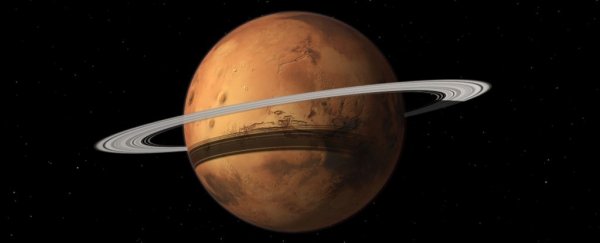It was only a fortnight ago that scientists at NASA announced Mars's moon Phobos is in the process of shattering apart due to tidal forces exerted on it by the red planet, and now a new study explains what this dramatic phenomenon could ultimately lead to.
The impending destruction of Phobos that's set to take place in the next 20 to 40 million years will result in the disintegrated moon forming a ring system around its parent planet, according to scientists at the University of California, Berkeley.
The researchers' calculations provide an answer to a puzzle scientists have long contemplated regarding the ongoing gravitational attraction between Mars and its larger moon. Phobos, which orbits Mars at a distance of just 6,000 kilometres, is gradually spiralling in towards the red planet, and the tidal forces pulling on Phobos are also responsible for weakening the structural integrity of the moon, which is believed to have a rubble-like core.
But while the gap between Mars and Phobos is closing at an extremely slow rate – narrowing by only a number of centimetres each year – the ultimate question remained: after millions of years, would Phobos inevitably collide with Mars, or would the tidal forces shatter the moon into smaller fragments before such an eventuality could take place?
According to the researchers, who used observational data and a geotechnical model to calculate the integrity of Phobos, the structural failure of the moon will precede any planetary collision.
"We suggest that – with continued inward migration of the moon – the weakest material will disperse tidally in 20 to 40 million years to form a Martian ring," the researchers write in Nature Geoscience. "We predict that this ring will persist for [1 million to 100 million years] and will initially have a comparable mass density to that of Saturn's rings."
The disintegration would be over relatively quickly, likely taking only a matter of days or weeks to complete. "If you were standing on the surface of Mars, you could grab a lawn chair and watch Phobos shearing out and spreading into a big circle," Benjamin Black, one of the researchers, told Alexandra Witze at Nature.
However, a reduced collision may still be on the cards after the ring formation. "Any large fragment of Phobos that is strong enough to escape tidal breakup will eventually collide with Mars in an oblique, low-velocity impact," the authors write.
The findings may also explain how the rings surrounding Saturn and other similarly encircled planets came to be – and could mean that Mars won't be the only planet in our Solar System getting a ring in the future. Neptune's largest moon, Triton, features similar stress marks to Phobos and is also believed to be moving closer to its parent planet, which may make Triton another candidate for eventual lunar disintegration.
